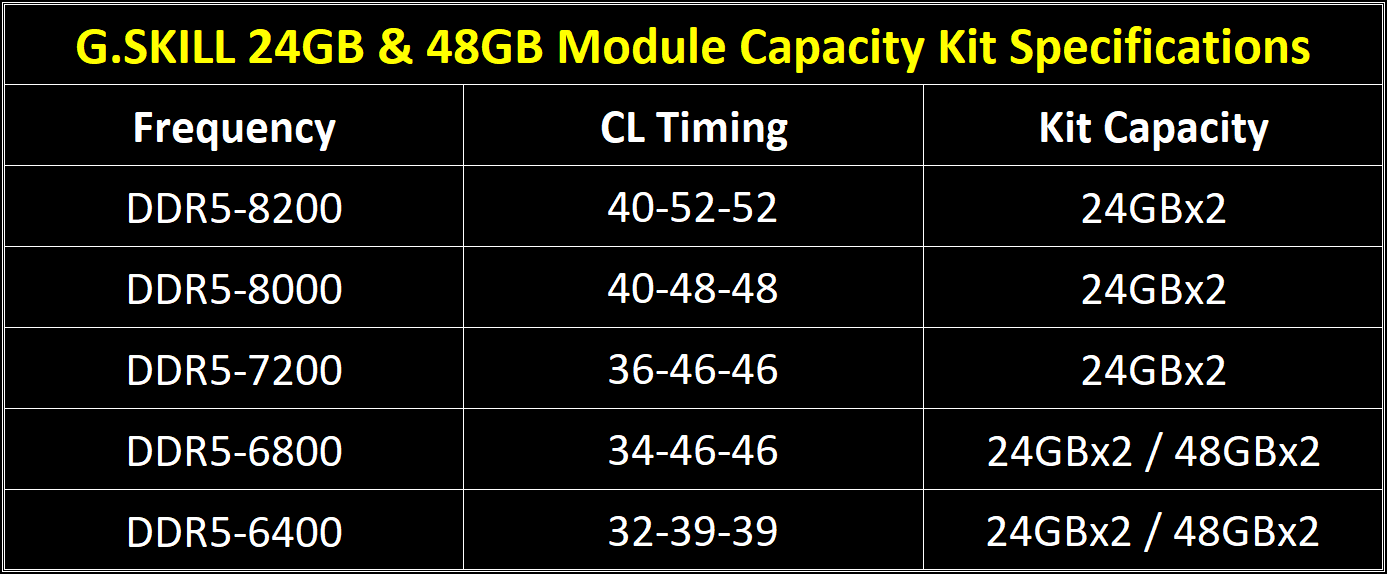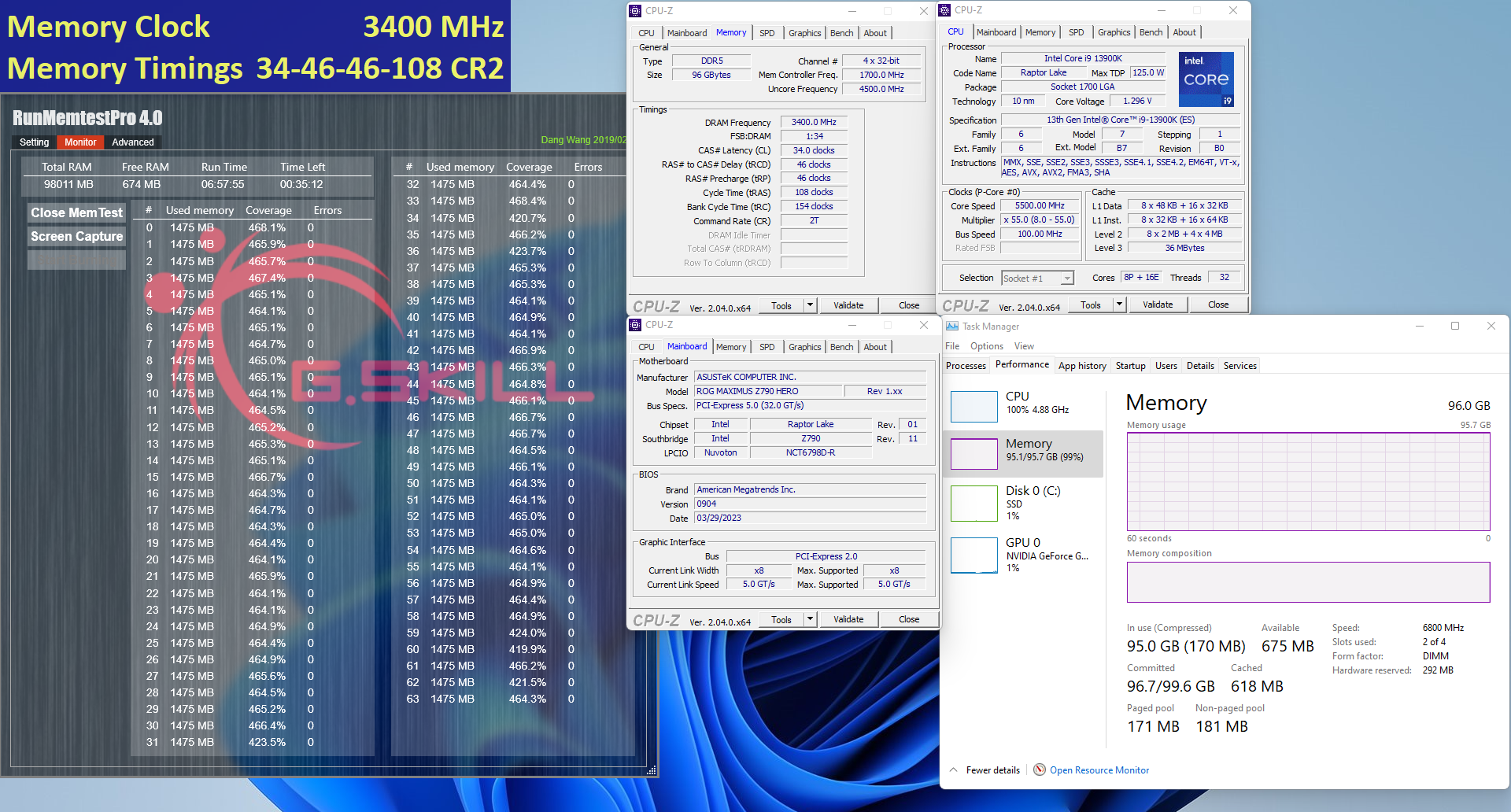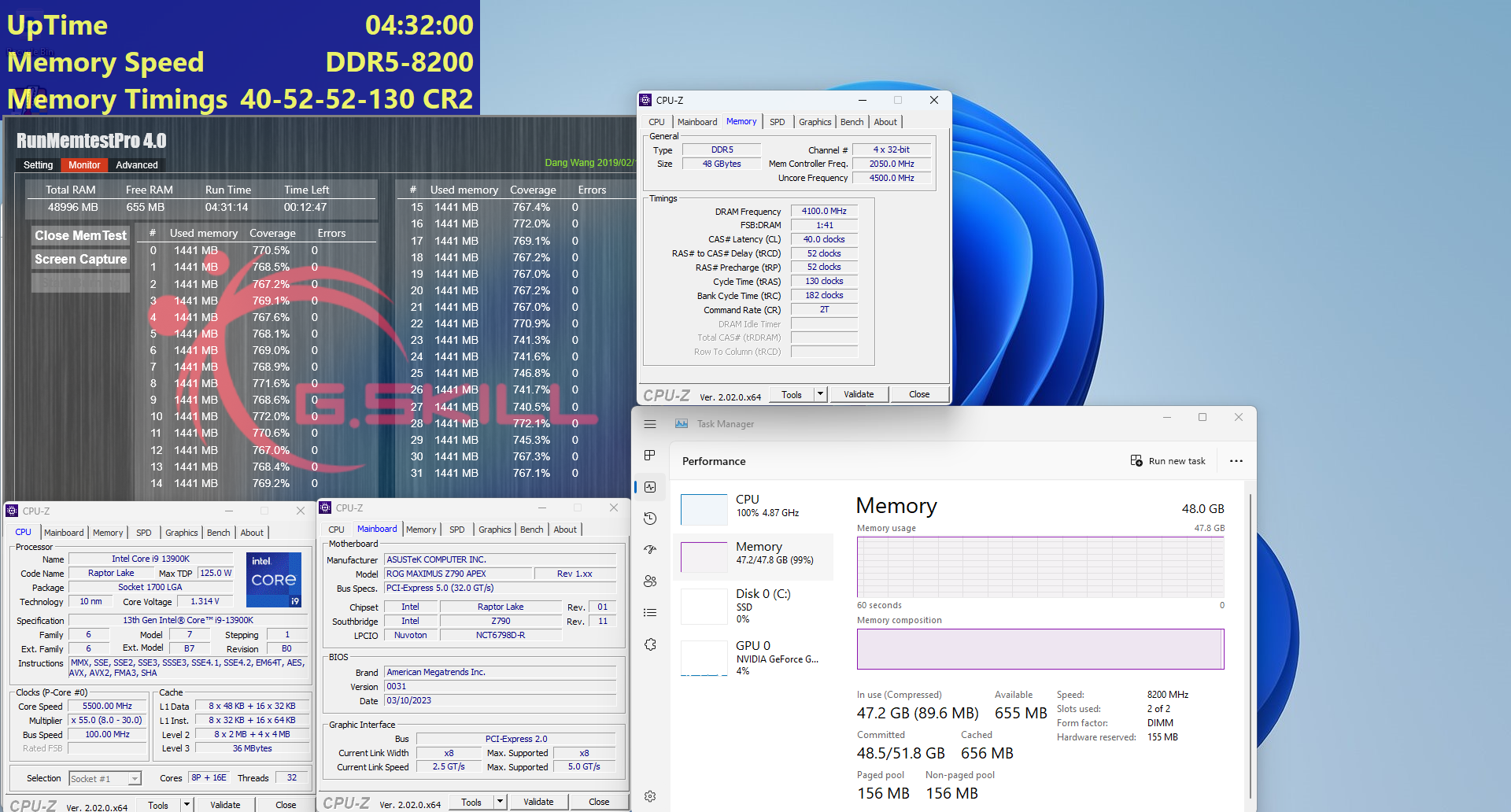G.Skill Announces Bleeding Edge DDR5-8200 48GB Kit
Enthusiast-grade DDR5 bandwidth beyond 32GB
G.Skill has announced five new Trident Z5 DDR5 memory kits for Intel platforms, featuring the all-new 24GB and 48GB capacity DDR5 modules and memory speeds of up to 8200MT/s. The 8200MT/s kit, in particular, will be among the fastest on the market, and it will come with more than 32GB of capacity.
To reiterate, only one DDR5-8200 kit is rated for that speed in the list. This will be a 24GB x 2 (48GB) DDR5 memory kit with 40-52-52 timings. For perspective, this kit has slightly quicker memory latency than a DDR5 5600MHz CL28 or 6000MHz CL30 kit. So it will be great for memory-sensitive applications, like gaming, and vastly superior for bandwidth-heavy workloads.
The next-fastest kits include a DDR5-8000 dual-channel kit and a DDR5-7200 dual-channel kit. The 8000MT/s version will come with 40-48-48 timings, and the 7200MT/s kit will come with 36-46-46 timings. Both feature a DDR5 capacity of 48GB split between two DDR5 sticks (2 x 24GB).
The last remaining kits are the slowest of the bunch, featuring 6800MT/s and 6400MT/s versions, but they come in significantly higher-capacity variants. The 6800MT/s version comes with 34-46-46- timings, and the 6400MT/s version comes with 32-39-39 timings. Both kits will come in two configurations, either a 2 x 24GB kit or a 2 x 48GB kit, giving users a total of 48GB or 96GB of memory capacity.
G.Skill showed off real-world memory tests of its 8400MT/s 48GB kit and 6800MT/s 96GB kit running MemtestPro 4.0 on a Core i9-13900K CPU and an ASUS ROG Maximus Z790 Hero. Both memtest results show perfect stability of the kits, with no errors.
The 48 GB and 96GB capacities are brand new to the consumer space and open a whole new wave of capacity options in the DDR5 market. Before, you were limited to 16GB, 32GB, 64GB, and 128GB capacities on mainstream platforms, utilizing either two or four memory sticks. Now with 24GB and 48GB modules, users can opt for 48GB, 96GB, and even 192GB options with either two or four sticks.
This will allow users to target more optimal memory configurations and not overpay for the additional capacity they don't need. For instance, if a user needs 80GB of RAM for a specific application, they would need to buy a 128GB kit to sufficiently hit that target. Now they can get much closer to that target with a 96GB kit, and pay for less memory overhead. The 192GB option is also nice since that option is much larger than the previous 128GB cap. (Again, this example applies only to mainstream platforms, not HEDT or workstations with more than four DDR5 slots.)
Get Tom's Hardware's best news and in-depth reviews, straight to your inbox.
All kits are designed for Intel DDR5 platforms only and support XMP 3.0. Technically you can run XMP on AMD Ryzen 7000 series counterparts; however, there's no guarantee of stability, and there is a good chance memory sub-timings won't be tuned optimally compared to a proper AMD EXPO kit.

Aaron Klotz is a contributing writer for Tom’s Hardware, covering news related to computer hardware such as CPUs, and graphics cards.
-
phazeshifta This isn't a kit meant to run on that 90% of boards though. This is meant for the best computers, not your mom's web browsing box.Reply
If you want to get RAM for that 90% of boards, you have plenty of other options...and that's just fine. -
SyCoREAPER What's with DDR5 using these odd kits of 24 and 48GB? I've been seeing this with various kits. Are traditional 8, 16, 32, 64 dead in favor of 24, 48, 96 (perspectively)?Reply -
thisisaname Replyphazeshifta said:This isn't a kit meant to run on that 90% of boards though. This is meant for the best computers, not your mom's web browsing box.
If you want to get RAM for that 90% of boards, you have plenty of other options...and that's just fine.
Going from Asus's web site the ASUS ROG Maximus Z790 Hero does not support 8400MT/s either.
https://rog.asus.com/motherboards/rog-maximus/rog-maximus-z790-hero-model/spec/
4 x DIMM, Max. 192GB, DDR5 7800+(OC)/7600(OC)/7400(OC)/7200(OC)/7000(OC)/6800(OC)/6600(OC)/6400(OC)/ 6200(OC)/ 6000(OC)/ 5800(OC)/ 5600/ 5400/ 5200/ 5000/ 4800MHz Non-ECC, Un-buffered Memory* -
bit_user Reply
It's just that the DDR5 standard added support for these half-steps. Maybe it was done out of concern that DRAM density improvements are starting to plateau?sycoreaper said:What's with DDR5 using these odd kits of 24 and 48GB? I've been seeing this with various kits.
I don't know why these high-speed kits are using those sizes, but for those limited to single-rank then 24 GB DIMMs are more attractive than the alternative of 16 GB DIMMs. Given the top $ these will cost, I guess that's meant to be an added benefit. Or, maybe it's just that the half-step die sizes are the latest generation, and therefore best-clocking?sycoreaper said:Are traditional 8, 16, 32, 64 dead in favor of 24, 48, 96 (perspectively)? -
SyCoREAPER Reply
Fianlly, someone answered, thanks. I was surprised to see that more weren't curious about it. Best info so far, thank you.bit_user said:It's just that the DDR5 standard added support for these half-steps. Maybe it was done out of concern that DRAM density improvements are starting to plateau?
I don't know why these high-speed kits are using those sizes, but for those limited to single-rank then 24 GB DIMMs are more attractive than the alternative of 16 GB DIMMs. Given the top $ these will cost, I guess that's meant to be an added benefit. Or, maybe it's just that the half-step die sizes are the latest generation, and therefore best-clocking? -
bit_user Reply
Here is a graphic that illustrates the plateau in DRAM density that I mentioned.sycoreaper said:Fianlly, someone answered, thanks. I was surprised to see that more weren't curious about it. Best info so far, thank you.
Source: https://www.tomshardware.com/news/3d-x-dram-roadmap-1tb-die-density-by-2030
The "extension" part is using a new 3D X-DRAM technology just announced by a company called Neo Semiconductor. -
kerberos_20 Reply
which still can take nosedive if nobody will use it, announced doesnt mean it will be available for consumers, there are many memory technologies announced superior to ddr and yet we are still on ddr several years laterbit_user said:The "extension" part is using a new 3D X-DRAM technology just announced by a company called Neo Semiconductor.
3d stacked ram has been in work for few years already, hbm pretty much kills competition, but ye if something better pops up, why not if it wont cost you leg and kidney -
bit_user Reply
Hopefully, NEO won't be as greedy as Rambus. It would be especially nice if someone found an alternate way to do 3D DRAM, and then NEO had to license its tech on the cheap, rather than at a price that makes it virtually uninteresting to DRAM makers.kerberos_20 said:which still can take nosedive if nobody will use it, announced doesnt mean it will be available for consumers, there are many memory technologies announced superior to ddr and yet we are still on ddr several years later


